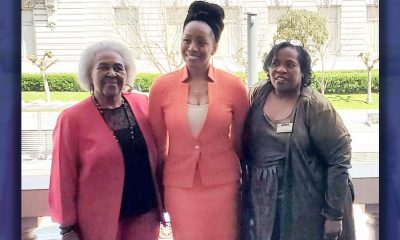Community
Homeless population increases 12% in L.A. County
WAVE NEWSPAPERS — Homelessness in Los Angeles County increased by 12% over the past year to reach an estimated 58,936 people, according to figures released June 4, with the region’s housing costs outpacing wages and forcing people onto the streets faster than authorities can find them shelter.
By Wave Wire Services
LOS ANGELES — Homelessness in Los Angeles County increased by 12% over the past year to reach an estimated 58,936 people, according to figures released June 4, with the region’s housing costs outpacing wages and forcing people onto the streets faster than authorities can find them shelter.
According to data released by the Los Angeles Homeless Services Authority, nearly three-quarters of homeless people are living in cars, tents, makeshift shelters or on the streets without any apparent cover from the elements.
“We have the largest unsheltered population in the nation and one of the largest homeless counts across America,” said Peter Lynn, director of the authority. “Only New York has more people experiencing homelessness on any given night.
The city of Los Angeles saw a 16% increase in its homelessness numbers.
Supervisor Janice Hahn, who chairs the county board, said she anticipated the rise given the increasing number of homeless encampments but called the figures “very disappointing, very troubling, very sad,” particularly after a 4% drop in the numbers last year.
Though the number of chronically homeless individuals increased by 17%, demographers and statisticians responsible for the count said they believe the real issue is the influx of newly homeless people.
Phil Ansell, who runs the county’s Homeless Initiative, said it may seem counterintuitive, but “a booming economy can actually lead to an increase in homelessness.”
He said that in a growing economy, rental rates have outpaced wages, particularly for people living at the margins and earning minimum wage. A minimum-wage employee would have to work 79 hours a week at $13.25 per hour to afford the rent in an average one-bedroom apartment, according to the homeless services authority.
Los Angeles Mayor Eric Garcetti echoed that sentiment, calling the increase in homelessness “heartbreaking.”
“These results remind us of a difficult truth: skyrocketing rents statewide and federal disinvestment in affordable housing, combined with an epidemic of untreated trauma and mental illness, is pushing people into homelessness faster than they can be lifted out,” he said.
The numbers are up despite tens of thousands of people who have moved off the streets and into permanent housing. In the last year alone, the county has helped 21,631 people find permanent homes while another 27,080 who were homeless at some point during the year were able to lift themselves out of homelessness, according to the data.
The number of homeless veterans was roughly flat year-over-year, but there were 7% more homeless senior citizens — after a meaningful decrease last year — and demographers saw a 24% jump in homeless youth. Researchers from USC who worked on the count said they believe improved methodologies were responsible for part of the increase in young adults.
Though people suffering from severe mental illness or with substance-abuse problems are among the most visible members of the homeless community, they make up just 29% of the total homeless population.
Black Angelenos are four times more likely to end up homeless, a finding consistent with data from earlier counts that Lynn attributed to “deep institutional racism in the culture.”
While the number of both sheltered and unsheltered homeless was up, most homeless families are in shelters or other bridge housing, according to the homeless services authority.
Economic hardship was the number one reason cited by newly homeless individuals for their plight. The second most common trigger was a lack of a support network and a personal crisis like a divorce. And 5% of those represented in the overall count said they were fleeing domestic violence.
The county has more than doubled its capacity to house people over the last five years, in part due to voter’s 2017 approval of a quarter-cent sales tax increase under Measure H in 2017. In 2016, voters in the city of Los Angeles approved Measure HHH, which authorized a $1.2 billion bond to build about 10,000 units of supportive housing.
But only 1,397 units are on track to be available in fiscal year 2019-20, according to the authority.
Hahn noted that a study by the nonprofit California Housing Partnership Corporation estimates that the county needs more than 500,000 affordable units to bring housing supply in line with demand from low-income residents.
Even at the rate of 10,000 units annually, “that’s 50 years before we will be able to build the number of affordable units we need,” Hahn said.
And those units cost an average of $450,000 to $500,000 to build, Hahn said, calling the number “staggering.”
County officials have backed a bill to speed conversions of motels into supportive housing units and is considering housing homeless veterans at the Bob Hope Patriotic Hall downtown, among other local efforts to increase the amount of shelter space, bridge housing and permanent supportive housing units as quickly as possible.
The county also has put a 3% cap on rental increases in unincorporated areas where they have that authority. However, California voters rejected a 2018 proposal to give local governments more latitude to enact rent controls.
Ansell said the state can take action immediately on three key issue that could help alleviate the problem, including pending legislation prohibiting rent gouging, evictions without cause and discrimination against renters with housing subsidies.
Los Angeles County officials said they are adding strategies geared at combating other economic factors. When the Board of Supervisors approved $460 million in 2019-20 Measure H spending on homelessness three weeks ago, it focused on finding ways to offset rising rental rates and to provide opportunities for steady employment through an employment task force and jobs training program.
But capacity constraints mean it will be some time before tent camps disappear and fewer people are forced to live in their cars.
“We have a long-term challenge ahead of us,” Lynn said.
He urged all Angelenos to join the United Way’s Everyone In campaign at www.everyoneinla.org and to advocate for policy changes and volunteer to help homeless individuals in their community. More information can be found at www.lahsa.org.
This article originally appeared in the Wave Newspapers.
Alameda County
DA Pamela Price Stands by Mom Who Lost Son to Gun Violence in Oakland
Last week, The Post published a photo showing Alameda County District Attorney Pamela Price with Carol Jones, whose son, Patrick DeMarco Scott, was gunned down by an unknown assailant in 2018.

Publisher’s note: Last week, The Post published a photo showing Alameda County District Attorney Pamela Price with Carol Jones, whose son, Patrick DeMarco Scott, was gunned down by an unknown assailant in 2018. The photo was too small for readers to see where the women were and what they were doing. Here we show Price and Jones as they complete a walk in memory of Scott. For more information and to contribute, please contact Carol Jones at 510-978-5517 at morefoundation.help@gmail.com. Courtesy photo.
City Government
Vallejo Welcomes Interim City Manager Beverli Marshall
At Tuesday night’s Council meeting, the Vallejo City Council appointed Beverli Marshall as the interim city manager. Her tenure in the City Manager’s Office began today, Wednesday, April 10. Mayor Robert McConnell praised Marshall’s extensive background, noting her “wide breadth of experience in many areas that will assist the City and its citizens in understanding the complexity of the many issues that must be solved” in Vallejo.

Special to The Post
At Tuesday night’s Council meeting, the Vallejo City Council appointed Beverli Marshall as the interim city manager. Her tenure in the City Manager’s Office began today, Wednesday, April 10.
Mayor Robert McConnell praised Marshall’s extensive background, noting her “wide breadth of experience in many areas that will assist the City and its citizens in understanding the complexity of the many issues that must be solved” in Vallejo.
Current City Manager Michael Malone, whose official departure is slated for April 18, expressed his well wishes. “I wish the City of Vallejo and Interim City Manager Marshall all the best in moving forward on the progress we’ve made to improve service to residents.” Malone expressed his hope that the staff and Council will work closely with ICM Marshall to “ensure success and prosperity for the City.”
According to the Vallejo Sun, Malone stepped into the role of interim city manager in 2021 and became permanent in 2022. Previously, Malone served as the city’s water director and decided to retire from city service e at the end of his contract which is April 18.
“I hope the excellent work of City staff will continue for years to come in Vallejo,” he said. “However, recent developments have led me to this decision to announce my retirement.”
When Malone was appointed, Vallejo was awash in scandals involving the housing division and the police department. A third of the city’s jobs went unfilled during most of his tenure, making for a rocky road for getting things done, the Vallejo Sun reported.
At last night’s council meeting, McConnell explained the selection process, highlighting the council’s confidence in achieving positive outcomes through a collaborative effort, and said this afternoon, “The Council is confident that by working closely together, positive results will be obtained.”
While the search for a permanent city manager is ongoing, an announcement is expected in the coming months.
On behalf of the City Council, Mayor McConnell extended gratitude to the staff, citizen groups, and recruitment firm.
“The Council wishes to thank the staff, the citizens’ group, and the recruitment firm for their diligent work and careful consideration for the selection of what is possibly the most important decision a Council can make on behalf of the betterment of our City,” McConnell said.
The Vallejo Sun contributed to this report.
City Government
Vallejo Community Members Appeal Major Use Permit for ELITE Charter School Expansion
Vallejo community members, former Solano County judge Paul Beeman and his wife Donna Beeman, filed an appeal against the approval of the Major Use Permit for the expansion of ELITE Public Schools into downtown less than two weeks after the Planning Commission approved the permit with a 6-1 vote.

By Magaly Muñoz
Vallejo community members, former Solano County judge Paul Beeman and his wife Donna Beeman, filed an appeal against the approval of the Major Use Permit for the expansion of ELITE Public Schools into downtown less than two weeks after the Planning Commission approved the permit with a 6-1 vote.
ELITE Charter School has been attempting to move into the downtown Vallejo area at 241-255 Georgia Street for two years, aiming to increase its capacity for high school students. However, a small group of residents and business owners, most notably the Beeman’s, have opposed the move.
The former county judge and his wife’s appeal alleges inaccuracies in the city’s staff report and presentation, and concerns about the project’s exemption from the California Environmental Quality Act (CEQA).
The Beeman’s stress that their opposition is not based on the charter or the people associated with it but solely on land use issues and potential impact on their business, which is located directly next to the proposed school location.
The couple have been vocal in their opposition to the expansion charter school with records of this going back to spring of last year, stating that the arrival of the 400 students in downtown will create a nuisance to those in the area.
During the Planning Commission meeting, Mr. Beeman asked Commissioner Cohen-Thompson to recuse herself from voting citing a possible conflict of interest because she had voted to approve the school’s expansion as trustee of the Solano County Board of Education. However, Cohen-Thompson and City Attorney Laura Zagaroli maintained that her positions did not create a conflict.
“I feel 100% that the attorney’s opinion is wrong,” Beeman told the Post.
He believes that Cohen-Thompson has a vested interest in upholding her earlier vote as a trustee and is advocating for people to ratify her opinion.
Cohen-Thompson declined to comment on the Post’s story and Zagaroli did not respond for comment.
The Beeman’s further argue that the school’s presence in the commercial district could deter future businesses, including those who sell alcohol due to proximity to schools.
According to Alcohol Beverage Control (ABC), the department can deny any retail license located within 600 feet of a school. Only one alcohol selling business is located within that range, which is Bambino’s Italian restaurant at 300 feet from the proposed location.
The project’s proponents argue that the school would not affect current or future liquor-selling establishments as long as they follow the ABC agency’s guidelines.
The Beeman’s also referenced Vallejo’s General Plan 2040, stating that the proposed expansion does not align with the plan’s revitalization efforts or arts and entertainment use. They argue that such a development should focus on vacant and underutilized areas, in accordance with the plan.
The proposed location, 241 Georgia Street aligns with this plan and is a two minute walk from the Vallejo Transit Center.
The General Plan emphasizes activating the downtown with, “Workers, residents, and students activate the downtown area seven days a week, providing a critical mass to support a ‘cafe culture’ and technology access, sparking innovation and entrepreneurship.”
City staff recommended exempting the project from CEQA, citing negligible impacts. However, Beeman raised concerns about increased foot traffic potentially exacerbating existing issues like theft and the lack of police presence downtown. He shared that he’s had a few encounters with kids running around his office building and disturbing his work.
Tara Beasley-Stansberry, a Planning Commissioner and owner of Noonie’s Place, told the Post that the arrival of students in downtown can mean not only opportunities for surrounding businesses, but can allow for students to find their first jobs and continue to give back to the community in revitalization efforts.
Beasley-Stansberry had advocated for the students at the March Commission meeting, sharing disappointment in the way that community members spoke negatively of the teens.
“To characterize these children as criminals before they’ve even graduated from high school, that’s when I had to really take a look and I was kind of lost as to where we were as a city and as a community to where I couldn’t understand how we were viewing these children,” Beasley-Stansberry told the Post.
She added that the commissioners who voted yes on the project location have to do what is right for the community and that the city’s purpose is not all about generating businesses.
ELITE CEO Dr. Ramona Bishop, told the Post that they have worked with the city and responded to all questions and concerns from the appropriate departments. She claimed ELITE has one of the fastest growing schools in the county with mostly Vallejo residents.
“We have motivated college-bound high school students who deserve this downtown location designed just for them,” Bishop said. “We look forward to occupying our new [location] in the fall of 2024 and ask the Vallejo City Council to uphold their Planning Commission vote without delay.”
The Vallejo City Council will make the final decision about the project location and Major Use Permit on April 23.
-

 Activism4 weeks ago
Activism4 weeks agoOakland Post: Week of March 27 – April 2, 2024
-

 #NNPA BlackPress4 weeks ago
#NNPA BlackPress4 weeks agoFrom Raids to Revelations: The Dark Turn in Sean ‘Diddy’ Combs’ Saga
-

 #NNPA BlackPress4 weeks ago
#NNPA BlackPress4 weeks agoCOMMENTARY: D.C. Crime Bill Fails to Address Root Causes of Violence and Incarceration
-

 #NNPA BlackPress4 weeks ago
#NNPA BlackPress4 weeks agoCOMMENTARY: Lady Day and The Lights!
-

 #NNPA BlackPress4 weeks ago
#NNPA BlackPress4 weeks agoMayor, City Council President React to May 31 Closing of Birmingham-Southern College
-

 #NNPA BlackPress4 weeks ago
#NNPA BlackPress4 weeks agoBaltimore Key Bridge Catastrophe: A City’s Heartbreak and a Nation’s Alarm
-

 #NNPA BlackPress4 weeks ago
#NNPA BlackPress4 weeks agoBaltimore’s Key Bridge Struck by Ship, Collapses into Water
-

 #NNPA BlackPress4 weeks ago
#NNPA BlackPress4 weeks agoBeloved Actor and Activist Louis Cameron Gossett Jr. Dies at 87















































